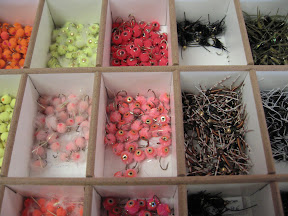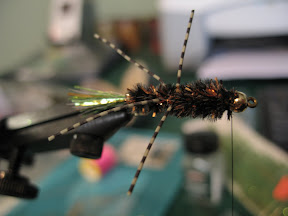Fly fishing for summer steelhead is peaking right now on the Middle Fork of the Willamette and McKenzie River near town.
 |
| From MattStansberry |
Last week I stood waist deep in the Middle Fork, watching my fly line float down and across the current. I had been catching 10-inch trout, rainbow and cutthroat, in the hours before dinner.
On my last cast before packing it in, I whipped my line into the middle of the river and let it swing through the tail out. I twitched the fly with a pull of my left hand and felt a tap. A split second later, the reel handle spun back so fast it nearly broke my thumb.
 |
| From MattStansberry |
The big fish didn’t give me time to dwell on my wound. It dug itself into the current and started yanking me into the river and taking line. I knew I had to land this fish or no one would believe me.
A short time later I had the giant sea-run rainbow on the bank, and a short time after that it was on my grill.
Brian Marz, owner of the McKenzie Angler fly shop in Walterville, OR said the good fishing will continue on both rivers. He recommended wade fishing the stretch below Leaburg Dam on the McKenzie during the week -- weekends are a zoo. He said boat anglers would have success drifting the Willamette from the D-Street ramp down to Valley River.
 |
| From MattStansberry |
According to Marz, who often guides in the area, the fish in the town runs can really turn aggressive with the falling temperatures, shifting daylight and fresh rain.
A heavy stonefly pattern or leech imitation with an egg fly dropper will catch a lot of fish on either river. It’s a down and dirty presentation, heavy flies and floating strike indicators, but it gets the job done. My personal choice over the past week has been a weighted olive wooly bugger with big rubber legs.
Marz said this year the fishing has been better than usual, especially on the McKenzie. He attributes this in part to the fact that Oregon Department of Fish and Wildlife hasn’t been trucking fish back down river from the Leaburg Hatchery -- an operation ODFW terms “recycling”.
In past years, ODFW biologists trapped adult steelhead stacking up outside of Leaburg Dam -- fish that are trying to return to the hatchery where they were reared. The biologists loaded steelhead onto trucks and then hauled them back down river where the anglers would have another shot at them.
According to Jeff Ziller, district fish biologist, this was done for two reasons. First, it gave anglers another shot at catching the fish as they ran up the river again. Secondly, it kept a number of fish from breaching the fish ladder at Leaburg Dam.
While ODFW rears and plants steelhead on the McKenzie system, they don’t want them to move upriver beyond the dam or reproduce. These stocked fish can carry a virus that could potentially affect wild trout populations upriver. Yet the waterway must remain open because ODFW cannot impede the migration of spring Chinook salmon. But the recycling program minimizes that risk.
This year, ODFW did not recycle the steelhead, and Marz said he thinks the fishing has been better as a result. “The recycled fish are thrown for a loop and won’t bite for a month,” he said. “You can pound a recycled fish in the face with a fly and it won’t bite. There are more fish biting this year, they are fighting more and have better flesh.”
Marz hadn’t spoken with biologists about his theory and was anxious to hear what they had to say.
Ziller agreed that there might be some validity to Marz’ idea, but he said other factors played into the better than average season.
Ziller said the river systems had more water this year and the fish didn’t get the summer doldrums. Also, 20,000 steelhead returned to the Willamette system this year, 25% more than last year’s count of 14,000.
With more and meaner fish in the system, the action should remain steady for the coming weeks. If you are interested in learning about how to fly fish for steelhead, the McKenzie Angler is offering a seminar on Sunday evening. For more information call (541) 736 5045.
No comments:
Post a Comment